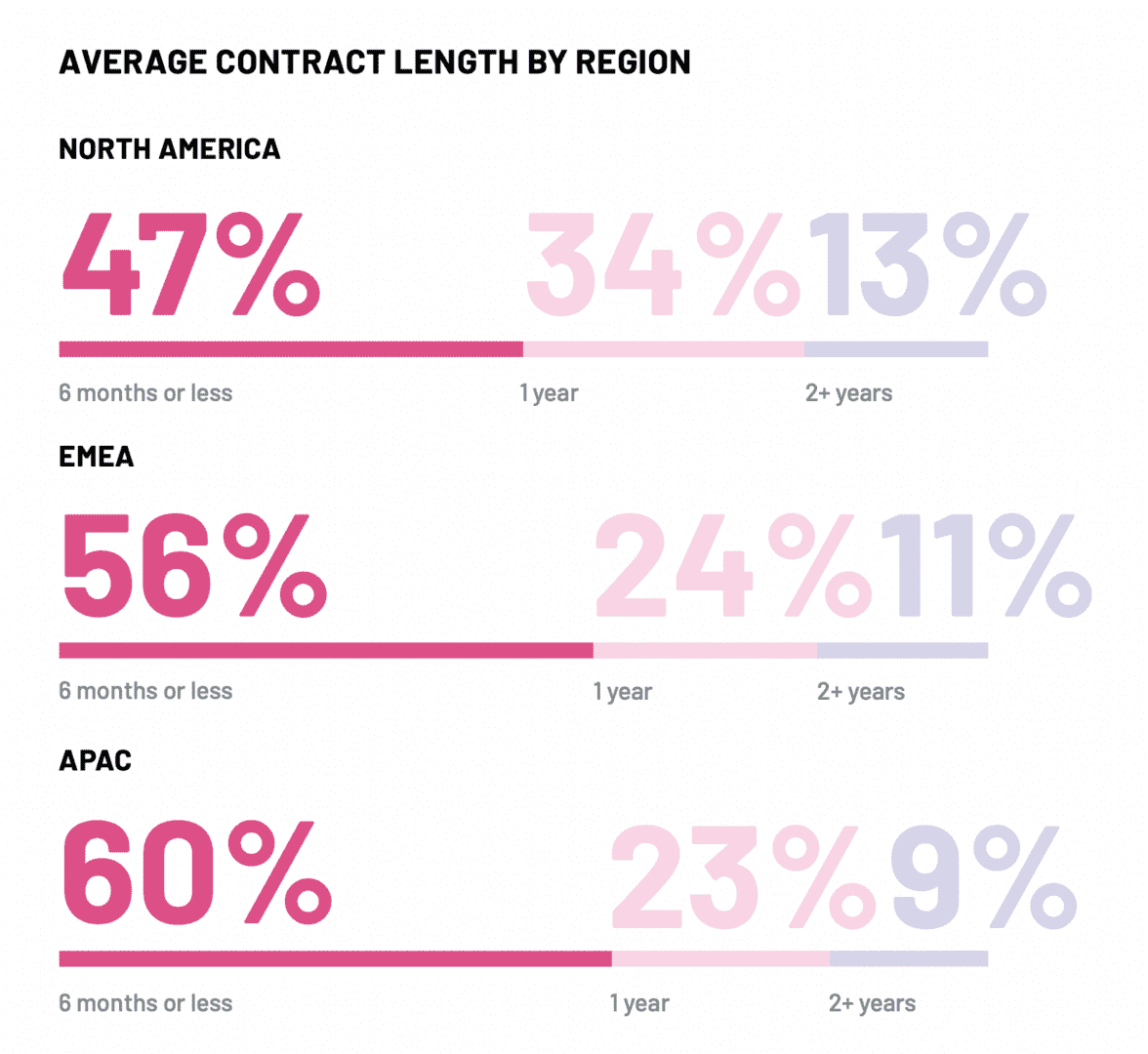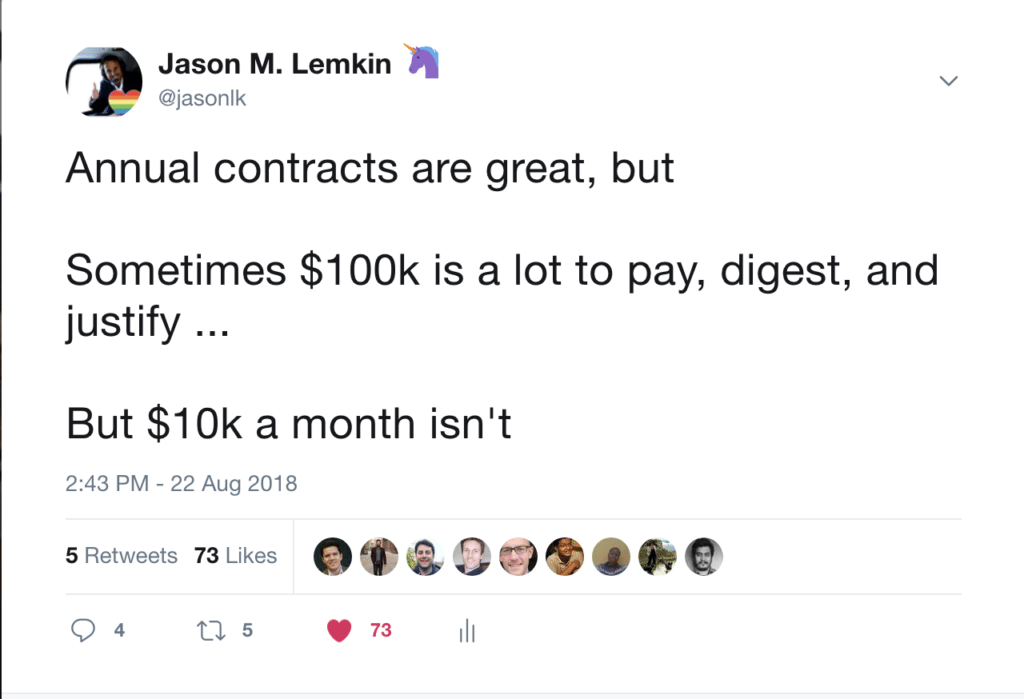Annual contracts seem so great. VCs love them, and they do seem to reduce churn.
Bigger customers usually leave simply because your product doesn’t do enough
An annual contract gives you 365 days or so to fix that
— Jason ✨Be Kind✨ Lemkin 🇮🇱 (@jasonlk) September 4, 2020
I’ve long been a vocal proponent of annual contracts. I felt like when I was a SaaS CEO and had to go profitable, they helped saved my rear. Close, say, a $125k contract, even after a healthy sales commission, that’s $100k+ in the bank right now! And if your burn rate is low (ours was probably $100k-$150k at the time we started to close bigger annual deals), that’s like a whole extra month of runway just on that deal. A multi-year pre-paid contract can be even more magical, and give you months of extra cash in a start-up.
This is still true. But as time has gone by, and I’ve worked with more SaaS companies, I’ve also seen the downside of annual contracts at many start-ups as well:
- Annual deal collections can be tough for start-ups. Bigger companies are good at this, but if you aren’t, you may not get the benefits of an annual contract if it takes you 4-6 months to actually collect the cash. Annual contracts require P.O., bills, “payment terms”, and often, repeated follow-up. Most start-ups don’t have a good enough finance person or firm to be good at collections. Forcing your sales team to do collections is OK in the early days, but doesn’t work perfectly either, and doesn’t scale. Monthly invoices can make things even worse, of course. But getting paid in a simple ACH or credit card payment each month can be magical.
- Annual deals can create unnecessary customer friction. Big customers will want to pay annually. So for sure, do that. It’s how their procurement departments work. But if you have an incentive structure where even SMBs are pushed to go annual … best case, that will add friction to your sales process. Is it worth it? I’m not sure. Let SMBs pick annual or monthly, at least as an experiment. You’ll see what they really prefer.
- Annual deals get sent to legal for review, procurement for negotiation, etc. This makes sense for a $250k+ deal. But for a smaller deal, you are again just making it harder on the customer and slowing down the close. The odds if a deal gets sent to legal that it closes the same month are close to zero. This always at least takes weeks. Avoid it if you can.
- Annual deals, done wrong, can create unnecessary (and even more importantly, perpetual) discounting. You almost always have to provide a 10%-20% discount to incent annual deals. Is it worth it? Maybe not as the account grows over time. In Years 2, 3, and 10, you may wish you had that discount back when you have to honor it, one way or another, in the renewal. You are robbing a bit of a long-term revenue stream if you over-discount to get an annual deal done now. This can compound with multi-year deals. If you tell a loyal customer in Year 2 you are taking away their discount … expect that loyalty to evaporate.
- Annual deals mask churn. This can be bad, not good. You may like annual deals for a second reason — they take a year to churn. But that’s not really true. It’s only true in your financial statements and your numbers. But if a customer never renews in SaaS, or if they stop using your product even if they’ve already paid for it for the year, it’s basically like they never really existed at all. A customer you lose next year doesn’t help you at all to get to $10, $20m, $100m in recurring revenue. A deal has to recur or in the medium and long run, otherwise it just doesn’t matter. Worse, it may mask weak efforts in customer success and retention efforts, and disincent you to track and grow NPS early.
- Annual deals are a tough fit with many API services and variable-usage services. It’s often better with variable revenue to move to an annual contract later in many cases, a few months later or even at renewal. But forcing customers to estimate variable usage before they are even in production, best case, again adds friction to a sales process. Is it worth it? I’d argue — rarely. In fact, MongoDB found revenue went up and sales cycles went down when they stopped forcing customers into annual contracts. More on that here.
Done right, with a strong collections team (or at least point person), thoughtful discounting, and a laser-attention on NPS, annual contracts are still a gift — no doubt. In fact, our team leveraged them to come up with a Collections Goal each month of 110%+ of our MRR. I.e., if our MRR was $500k, we needed to collect at least $550k that month in cash. We often beat it and hit 120% by setting that as our goal. That was great. It really was. More on that here.
But more important these days, when customers are veterans, and have been buying SaaS products for 20 years, is to let them buy the way they want. At least until you are huge, and have a dominant brand. That’s the fastest, easiest way to scale, with the most satisfied customers.
Don’t force annual contracts where they don’t fit.
(note: an updated SaaStr Classic post)




